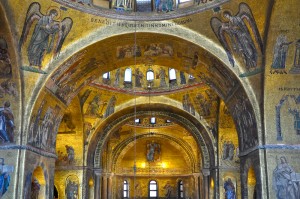St Mark’s Basilica and the history of mosaics
St Mark’s Basilica and the history of mosaics
St Mark’s Basilica and the history of mosaics
-
Hannah
-
Hannah
 My heroine in The Echoes of Love, Venetia, is by profession a professional restorer of mosaics, a job requiring a great deal of skill, care and knowledge. She is well placed to carry out her work, located as she is in Venice, which played a key part in the history of the mosaic.
My heroine in The Echoes of Love, Venetia, is by profession a professional restorer of mosaics, a job requiring a great deal of skill, care and knowledge. She is well placed to carry out her work, located as she is in Venice, which played a key part in the history of the mosaic.
The earliest mosaics discovered date back some 4,000 years, just simple patterns made with pebbles, but it was the ancient Greeks who elevated the mosaic to an art form, and their work was soon taken up by the Romans. From the 5th century onwards, at the time of the rise of the Byzantine Empire, the creation in Italy of glass tesserae changed the look of the mosaic to that with which we are familiar today. The tesserae (from the Greek for ‘four-sided’) were made from large sheets of opaque, brightly coloured glass, sometimes with silver or gold leaf on the back, and were set at slight angles to reflect light around a room. Mosaics until that point had been largely set into floors, but now walls and ceilings became wide canvases for this art.
In twelfth-century Venice, Byzantine mosaics were all the rage. The Torcello Cathedral contains several stunning examples, including a huge mosaic of the Last Judgement, and St Mark’s Basilica in the city is aglitter with golden mosaics that span in total about an acre, earning the basilica the name Chiesa d’Oro, ‘Church of Gold’ (for detailed pictures, click here).
To this day, Venetian company Orsoni, which began trading back in 1888, remains one of the most prestigious producers of mosaic tiles in the world, having supplied materials for the Trocadéro and the Basilica of the Sacre Coeur in Paris, Saint Paul’s Cathedral in London and the Sagrada Familia in Barcelona. For a glimpse of some of the stunning tesserae available, visit the Orsoni website. Orsoni also offers a mosaic course for those who want to learn from the masters of the craft.
No doubt my character Venetia would have attended the Orsoni course. And I wish I could too…
A common question I am asked in author interviews is: ‘How much of yourself do you put in your characters?’ The answer is always, ‘A little, but my characters are not direct reflections of me.’ When it comes to Venetia’s career, I suppose you could say I am living vicariously. How I would love to do her job, to have studied as she has, to have visited so many of the world’s most beautiful ancient mosaics!